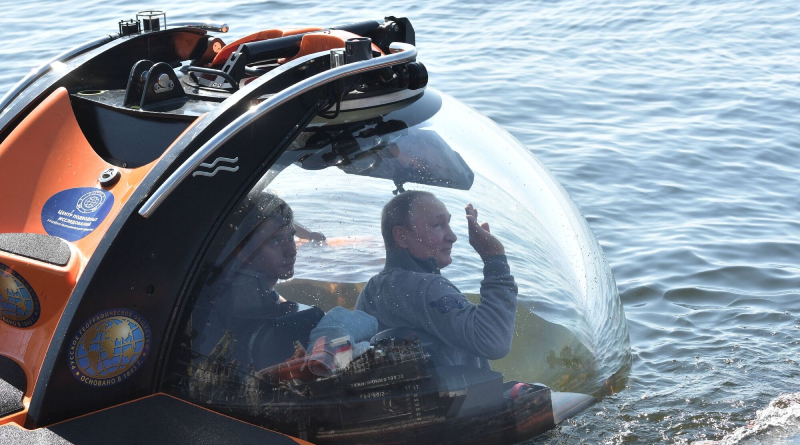Russia’s Scariest New Threat Is Underwater, Not in Space
A UK study of undersea cables shows that the global network carrying almost all internet and financial traffic is highly vulnerable to sabotage.
By James Stavridis, former supreme allied commander of NATO, and dean emeritus of The Fletcher School
Mike Turner, chairman of the House Intelligence Committee, warns that the US is “sleepwalking into an international crisis” by ignoring Russia’s intent to put nuclear weapons in space and use an electro-magnetic pulse to disable the constellation of satellites that underpins our intelligence, navigation and warfighting capabilities. He is right to be concerned that this capability — although not in place yet — is a serious challenge for the West. But there is an even more vulnerable Achilles’ heel that threatens global commerce, worldwide military readiness and logistics, and the internet itself: the highly vulnerable complex of undersea cables that provide the backbone of the world’s connectivity.
How big is the threat to undersea cables, and what should we be doing about it?
In a report released early this week by the highly regarded and nonpartisan Policy Exchange of the United Kingdom, the vulnerabilities become chillingly clear. The new report, which I have endorsed and recommended to US policymakers, is a sequel to a 2017 analysis co-authored by the current British prime minister, Rishi Sunak. (I wrote a forward to the 2017 effort, and since then I have become even more deeply concerned about this glaring global vulnerability.)
The new report lays out the facts quite clearly: Globally, more than 10 trillion dollars of financial transactions, commercial payments, and trade transactions occur daily. Well over 95% of the world’s communications are carried by a network of roughly 500 cables laid across the seven seas. As the 2017 report says, “Undersea cables come ashore in just a few remote, coastal locations … [and] often have minimal protection. Most Americans think the internet is supported by satellites in space. Wrong — it is a relatively small handful of deep seabed cables that carry the system.”
As a former British chief of defense, Air Chief Marshal Stuart William Peach, says in the forward to the new report, “Moscow has already begun probing Atlantic undersea infrastructure as the weak underbelly of our national security.” He goes on to point out that, “Further east, China is fortifying its undersea defenses as part of its wider aspiration to become a great military power.” Other rogue states, including Iran and North Korea, are improving their undersea military capabilities in ways that could threaten this critical infrastructure.
A decade ago, I was much more concerned about terrorism. As the North Atlantic Treaty Organization’s military commander, I directed assessments of whether al-Qaeda and similar organizations could disrupt the global economy by attacking the cables, and our focus was the land side (they are equally vulnerable where they make landfall). We thought it unlikely that terror groups could go after the deep seabed.
But today, with the return of dangerous great-power competition between the US, China and Russia, the entire structure of the system is at risk. Particularly, Russian submarines (and some of their surface “research” vessels that are really spy ships) probably have the ability to go down to very deeply laid stretches of the cables and disrupt them — either by destroying them or tapping into them to manipulate data. (In my novel, 2034: A Novel of the Next World War, Russia goes after the undersea cables at a critical moment in an ongoing war between the US and China, seeking to play a spoiler role.)
The first thing to do is simply realize how vulnerable these underwater communication systems have become. In the West, we need to conduct more war games that study the specifics of the vulnerabilities and understand where the weakest points are located. A glance at a map of the system in the UK report quickly shows a nexus of such points and overlaying trade routes (as between huge economies like the US and European Union, or the US and Japan), giving an idea of where adversaries might strike. Seabed warfare is coming.
We also must increase the technology we are applying to protect the cables. While they are reasonably well insulated with layers of various protective coverings, they could be further hardened with new types of materials including epoxy-based glass flake coatings or aliphatic polyurethane paints. Likewise, we should be laying classified “dark cables,” which are not in use on a day-to-day basis but could be switched on in the case of an attack on the principal network.
We should also be exploring data compression concepts that would, over time, permit more use of space-based alternatives. With breakthrough transmission systems it might be possible to use long-haul atmospheric systems as well; dirigibles could have a role to play. The point is, we must explore alternatives aggressively.
On both the offensive and defensive sides, we need to invest in seabed warfare. That means improving our own undersea systems, including nuclear submarines and new classes of undersea unmanned vehicles that can counter enemy craft. We will also need to foster deterrence by being able to put at risk cables important China and Russia. This should be done in full cooperation with our partners: NATO, Japan, South Korea and other advanced maritime nations. We should also collectively be doing more advanced mapping of the deep seabed, of which only 20% has been done at high resolution.
Finally, as with nuclear weapons and general maritime operations, there is a potential role for arms-control measures. Given how critical these systems are to the overall global economy, it is conceivable that the US and China could construct protocols outlawing interference with the cable networks. (There might be more room for compromise on that front than on nuclear weapons, given China’s expansion of its arsenal.)
(This post is republished from Bloomberg Opinion.)

